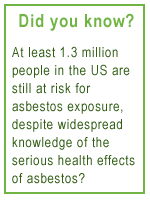Health Effects of Asbestos
www.healtheffectsofasbestos.com
Home >> About Asbestos >> What is Asbestos?
What is Asbestos?
 When a loved one has been exposed to asbestos and has subsequently developed an asbestos-related disease, the best place to start is to learn more about asbestos. The term asbestos refers to six naturally occurring fibrous minerals that are found naturally in some environments and in commercial products to which they have been added. Asbestos exists on every continent and in hundreds of countries worldwide. While the U.S. Bureau of Mines lists over 100 mineral fibers as “asbestos-like,” the U.S. government regulates only six of these asbestos minerals due to their known harmful health effects on humans.
When a loved one has been exposed to asbestos and has subsequently developed an asbestos-related disease, the best place to start is to learn more about asbestos. The term asbestos refers to six naturally occurring fibrous minerals that are found naturally in some environments and in commercial products to which they have been added. Asbestos exists on every continent and in hundreds of countries worldwide. While the U.S. Bureau of Mines lists over 100 mineral fibers as “asbestos-like,” the U.S. government regulates only six of these asbestos minerals due to their known harmful health effects on humans.
Asbestos particles are virtually invisible to the naked eye so it can be difficult to know whether or not you have been exposed. Learning where asbestos has been used, how people are exposed to asbestos, and the health effects of asbestos (all explained here) can help individuals and their families understand more about asbestos exposure.
 Though asbestos has been used in myriad countries, it was first introduced onto the American industrial scene in the 1850s. Throughout the rest of the 19th and into the 20th centuries, asbestos use skyrocketed. In fact, at the peak of its use in the 1960s and 70s, over 3,000 commercial products contained asbestos and over 810,000 metric tons were used annually.
Though asbestos has been used in myriad countries, it was first introduced onto the American industrial scene in the 1850s. Throughout the rest of the 19th and into the 20th centuries, asbestos use skyrocketed. In fact, at the peak of its use in the 1960s and 70s, over 3,000 commercial products contained asbestos and over 810,000 metric tons were used annually.
Why was asbestos so popular? Asbestos was prized for its durability, insulating properties, sound-proofing qualities, heat and flame resistance, insolubility, lack of odor, and more. In short, it was a manufacturer's dream. However, the serious health effects of asbestos became widely known in the 1970s and 80s and the use of this material slowly declined. It is important to note here that many commercial manufacturers who were utilizing asbestos in their products knew about the health effects of asbestos as early as the 1920s.